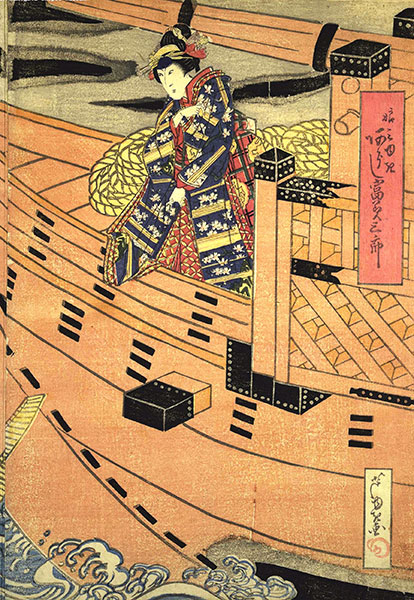Riverboats floating in kabuki plays
March 5 (Tue), 2019 – June 2 (Sun), 2019
This museum exhibits ukiyo-e woodblock prints produced in Osaka in the Edo period. Most of the ukiyo-e prints made in Osaka were portraits of kabuki actors in which you can see how the stage and the actors were like at the time.
The Horikawa River runs all over Osaka like a net, thus the city is called “water city”. Horikawa riverboats supported the physical distribution and the economy of Osaka. The Dotombori River runs near the kabuki theatres (Naka-za and Kado-za). People used boats to go to the theatres and as the kabuki opening ceremony was (and is) held on board, riverboats and the Osaka kabuki plays have strong relations.
In this feature exhibition, we focus on the kabuki plays that features riverboats. In kabuki plays, riverboats carry not only people and goods but also the story and feelings of characters. Welcome aboard the riverboats in ukiyo-e.

“Keisei Tsukushi Tsumagoto”, By Ashiyuki
Boats in the Edo period
Japanese ships went abroad such as China since ancient times, but going to and trading with other countries were banned during Kan’ei era (1624-1645).
Under this policy, in Japan as an island country surrounded by the sea, large wooden sailing ships called bezaisen including higaki-kaisen, taru-kaisen (merchant ships) and kitamae-bune that carried goods along the Japan sea played an important role around the country. There were variety of ships according to the types of cargo and purposes, such as sanjikkokubune that commuted between Kyoto-Fushimi and Osaka along the Yodogawa River, yakatabune (literally means home-style boat) that was used for pleasure, and chokibune on which men went to Yoshiwara (red-light district) in Edo city.
In kabuki plays, there are scenes that boats that a person he/she was seeking each other was on board pass by or scenes of fighting on board in the middle of raging wave. These scenes make a dramatic climax of the story.
Boats in kabuki plays
There are departures and farewells on board in kabuki plays.
In “Kokusenya-kassen”, Watonai leaves Hirado, Nagasaki to China to help restore the Ming dynasty. In “Hachijin shugo no honjo”, Kato Kiyomasa, after being poisoned, goes back in gozabune, luxurious riverboat, as if nothing had happened. Thus the story of a main character starts to move by a boat.
In “Shunkan”, the main character sees someone off while he himself doesn’t get on a boat. In “Imoseyama onna teikin”, after committing suicide, only the head tragically crosses the river in a boat to be a bride.
It can be said that a bo
at in a play carries main character’s feelings.
A boatman fights with a “kai”.
As in “funatoku”, famous rakugo title, a powerless young master cannot easily row a boat. “Sendo mono (boatmen story)” is a kabuki dance performance of a stylish and vigorous boatman, showing that how popular job a boatman was.
The paddle that a boatman holds in ukiyo-e is called “kai”, a steering tool. There are many fighting scenes using “kai”, and sometimes they use an oar to fight.
Bustle at the “funa-norikomi” (boat parade)
“Funa-norikomi”, still held today, is a tradition dating back to the Edo period. It was/is held before the first performance was/is given at the Dotombori theatres or when actors came back from Edo city and gave special performance. Sponsored by patrons, the boat parade was/is held on a large scale.
The displayed drawing depicts large crowd of spectators coming along the Dotombori River and full of actors’ boat and many other boats in the river. You can see how popular the kabuki plays were and the bustle of the parade at the time.
Famous places in Osaka
As the Edo period comes to an end and the modernization progresses, ships becomes western-style, a steamship is depicted in “Kawaguchi hatoba (wharf)”. But in “Sakuranomiya yori zoheikyoku wo nozomu (looking at Osaka mint bureau from Sakurano-miya)”, yakatabune is drawn which shows people at the time still loved the Japanese-style boats.